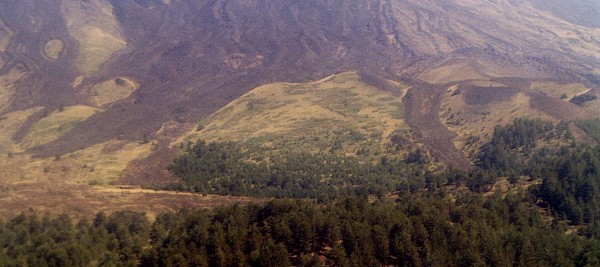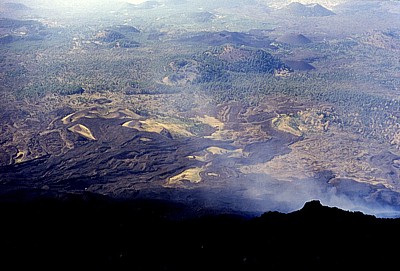| Etna
index |
||
| Geology | Geological history | Cones and craters |
| Eruptive characteristics | Eruptions before 1971 | Eruptions since 1971 |
| Etna and Man | References | Web sites |
| Weather forecasts | FAQ | Latest news |
Mamma
Etna's countless children
Monte Palestra
W flank, 14.94093° E, 37.74256° N
Summit elevation: 1883 m (W rim of W crater)
![]()
The
origin of the name "Monte Palestra" is uncertain - palestra
in Italian means a sports hall, a gymnasium - no such structure does actually
exist within a range of more than 10 km from this cone. To hikers doing
the spectacular three-day excursion along the Forest Guard Road (strada
forestale) from the "Milia" gate to the northeastern side of
Etna (or vice versa), Monte Palestra marks the highest point of the entire
tour - nearly 2000 m. The cone actually rises to an elevation of 2033
m and is a rather complex feature built on an eruptive fissure with several
vents including two major craters. The upslope side of Monte Palestra
has been largely buried and surrounded by lava flows probably produced
during a large summit eruption in 1787, with some of the upper vents forming
an "island" (named "dagala" in the Sicilian dialect)
within these flows.
About 0.5 km to the NNW of Monte Palestra lies a small but nice mountain
hut of the same name, which offers shelter to hikers that arrive in the
area in the late afternoon and need to spend the night in a protected
place. A cistern generally contains water of sufficient quality to be
used for cooking.
Although I have passed numerous times next to Monte Palestra, I never
climbed it so far. The best photographs of it were obtained when climbing
down the steep western flank of Etna during the massive October-November
1999 eruption at the Bocca Nuova.
Copyright © Boris Behncke, "Italy's Volcanoes: The Cradle of Volcanology"
Page set up on 15 December 2003, last modified on 21 February 2004


